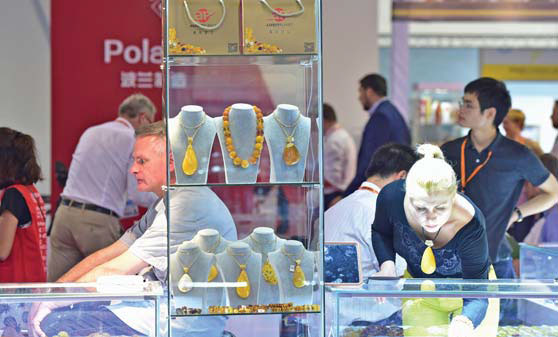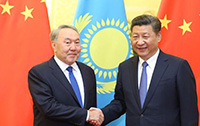Poland proves its worth as a partner
By Wang Mingjie (China Daily Europe) Updated: 2016-06-17 08:29President Xi Jinping's state visit to Poland, just six months after his Polish counterpart's trip to China, is a clear message that Poland is an important partner for China in Central Europe, a leading think tank analyst says.
Justyna Szczudlik, a China specialist with the Polish Institute of International Affairs, says: "This is evidence that bilateral relations on the political and high-level are excellent. Political dialogue is regular, very intensive, comprehensive and institutionalized."
Poland, she says, perceives the Belt and Road Initiative as an opportunity to enhance bilateral economic cooperation, which despite being upgraded to a strategic partnership in 2011 is still rather modest.
|
Finest Amber and honeystone from Poland are on display in the 2016 China Yiwu Imported Commodities Fair. Lv Bin / For China Daily |
Figures from the International Trade Centre show Polish imports from China stood at $14.5 billion (12.9 billion euros) last year while exports were just $2 billion.
Szczudlik says the Belt and Road Initiative will be useful in expanding Polish exports to China, admitting that Poland also sees the initiative as a means to attract Chinese investment.
To further strengthen collaboration between the nations, she suggests the initiative be connected with the Morawiecki Plan, which assumes reindustrialization and improvement of infrastructure in Poland.
"In other words, Chinese capital and technologies could be used in infrastructure projects like the Via Baltica (a road through the Baltic States and Poland), the Via Carpathia (an ancient route connecting the Baltic Sea and the Aegean), high-speed trains, and the modernization of sea ports."
Poland was the first Central European country to join the China-initiated Asian Infrastructure Investment Bank as a founding member.
Szczudlik says: "Poland's membership of the AIIB is a natural implementation of the Polish diplomatic agenda of reinvigorating relations with Asia, especially China. The Polish application was another message that Poland is consequently filling a rather vague concept of the strategic partnership with real content."
At the initial stage, the bank may be a source for Polish companies to gain knowledge about Chinese and Asian markets, while in the longer perspective it could be a venue for launching cooperation with Asian counterparts and facilitating Polish exporters' entry into Chinese and Asian markets, as well as attracting Chinese investment to Poland, she says.
Although the general political and economic climate in Poland is welcoming, the stock of Chinese investments in the country is believed to be low.
One of the reasons, Szczudlik says, is the semantic difference in investment perception, adding: "Poland would like to attract greenfield, brownfield and research and development investments, as they create jobs and lead to technology transfer. But China is still interested in mergers and acquisitions, which provide access to the existing infrastructure, management resources and distribution channel."
She notes that it seems Chinese entrepreneurs are not familiar with European Union law, especially regulations related to public procurement. In that sense, China is still learning about Poland's investment conditions and regulations.
"What's more, both sides are waiting for project proposals from the other side, and both countries present a rather reactive and passive approach," she says.
Nevertheless, she adds, this approach is changing. The best examples are Poland's project proposals presented during the visit by the Polish foreign minister to China in April.
Xi's visit to Poland and Serbia comes only months after he visited the Czech Republic, which was hailed by analysts as "clear evidence that Central and Eastern Europe is no longer on the peripheries of China's foreign policy".
wangmingjie@mail.chinadailyuk.com





